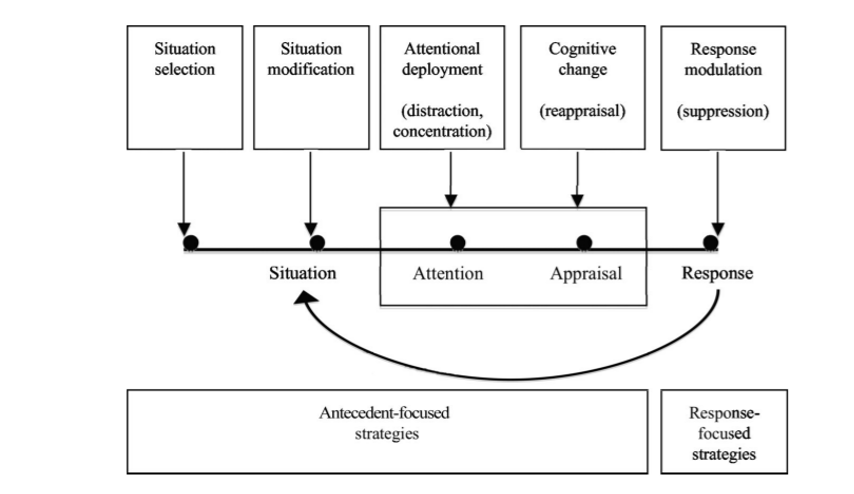Chapter 14 – Emotion Regulation
Process Model of Emotion Regulation
James Gross is an emotion researcher who focuses on emotion regulation. Gross (1998, 2002) developed the process model of emotion regulation (see Figure 2). This model identifies five emotion regulation strategies that occur during different time points in the emotion experience: situation selection, situation modification, attentional deployment, cognitive change, and response modulation. Gross (1998) further divides these strategies into antecedent-focused and response-focused. Antecedent-focused regulation occurs before the emotion is fully experienced or during the emotion experience, whereas response-focused regulation occurs after the emotion has completely developed. So, with response-focused people have already “responded” to the eliciting event and thus have experienced all the emotion component changes. Within response-focused, people can regulate their emotions by trying to change any of the emotion components. They might change their facial expressions and vocal tone, suppress their thoughts, increase or decrease their physiological arousal, and even change their subjective feelings.
Look at Figure 2. Which strategy occurs earliest in the emotion experience? Which occurs last? Although this model depicts the timing of regulation, Gross (2008) points out that the regulation processes can occur simultaneously. For example, if you meet your friend for coffee to discuss an argument you had with your parent, you are actively selecting to go to coffee and while at coffee also trying to consciously lower your arousal level.
Figure 2
Process Model of Emotion Regulation

Long Description
The diagram depicts a framework for emotion regulation, consisting of five boxes arranged horizontally in a sequence. Each box is labeled from left to right as: “Situation selection,” “Situation modification,” “Attentional deployment (distraction, concentration),” “Cognitive change (reappraisal),” and “Response modulation (suppression).” Arrows point downward from each box to a horizontal line beneath them, labeled “Situation,” “Attention,” “Appraisal,” and “Response” with “Attention and “Appraisal” in their own box. This line represents the progression through these stages. A box labeled “Antecedent-focused strategies” is positioned below the first four stages, while “Response-focused strategies” is beneath the last stage. An arrow loops back from “Response” to “Situation,” indicating feedback.
Reproduced from “Emotion Regulation: Conceptual Foundations,” by J.J. Gross and R.A. Thompson, 2007, in J.J. Gross (Ed.), Handbook of Emotion Regulation, p. 10, Guilford Press. Copyright 2007 by Guilford Press.

